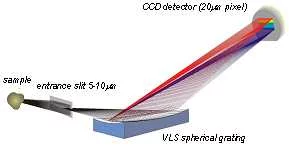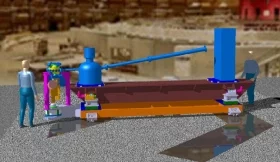SX-ARPES Endstation
The ARPES experiment in the soft-X-ray energy range (SX-ARPES) benefits, in first place, from increase of the photoelectron escape depth λ by a factor of 3-5 compared to the conventional VUV energy range. Along with enhancement of the bulk sensitivity, this improves the intrinsic resolution in surface-perpendicular momentum kz=λ-1 and, in combination with free-electron final states and simplified matrix elements, enables reliable investigations of electronic structure of 3D materials with high resolution in 3-dimensional k-space. Furthermore, the increase of λ, particularly in combination with elemental and chemical state specificity achieved by resonance photoemission, enables access to buried heterostructures and even isolated impurities. The worldwide highest flux delivered by the ADRESS beamline in the soft-X-ray energy range breakes through the problem of small photoexcitation crossection with soft-X-rays.
The SX-ARPES endstation uses an experimental geometry (Figure 1) with 20o grazing light incidence angle to increase the photoyield. The CARVING manipulator provides the polar, azimuth and tilt angular degrees of freedom. It is mounted horizontally that the grazing incidence affects only the smaller vertical size of the light footprint. The spot size in projection on the sample surface is ~30 x 74 µm2. The manipulator is liquid-He cooled, allowing sample temperatures down to 10.5K. The analyser PHOIBIOS-150 delivers constant angular dispersion through the whole operative energy range with a resolution better than 0.07o at 1 keV kinetic energy. The combined energy resolution ΔE is normally beamline limited. The analyser is rotatable around the lens axis, which permits orientation of the slit either along the incident beam to exploit symmetry of the valence states, or perpendicular to effectively sample the k-space with the primary manipulator rotation. Practically, operation at photon energies around 900 eV with ΔE ~ 100 meV delivers angle-resolved spectra of publication quality within 5 min, and with ΔE ~ 50 meV within 30 min.
The vacuum system (Figure 2) consists of the following chambers: (1) analysis chamber (AC) which houses the ARPES analyser; (2) transfer chamber (TC) equipped by LEED, which is a hub to exchange samples between all chambers and load lock (LL) as well as perform low-T cleavage; (3) preparation chamber (PC) which provides sample preparation facilities: gas exposure, ion bombardment, heating up to 1000oC, and thin films deposition with a possibility to accept user sources. The radial layout of the ARPES endstation fastens transfer of the cleavable samples from LL to AC, and eliminates contamination of the AC by residuals of sample preparations from PC.
Presentations:
- An early presentation from 2011 which gives a detailed account of the science case, endstation design and results of a few pilot experiments, including VSe2, HTSC pnictide Ba0.6K0.4Fe2As2, excitonic insulator TiSe2 (collaboration with Uni Fribourg), heavy-fermion intermetallic EuRh2Si2 (TU Dresden) and Fermi surface of buried LNO/LAO heterostructures (Uni Wuerzburg).
- A recent presentation from 2013 which extends the applications of SX-ARPES from 3D bulk materials (3D charge density waves in VSe2, 3D Fermi surface of LSMO) to buried heterostructures (LAO/STO interfaces, collaboration with the Materials Science group of SLS) and impurity systems (GaMnAs diluted magnetic semiconductors, collaboration with Uni Tokyo)
RIXS Endstation
The RIXS endstation allows investigations of strong electron correlations encountered, for example, in superconductors and heavy fermion systems. Moreover, large probing depth of soft X-rays gives access to nanostructure systems. The endstation is equipped with an ultrahigh-resolution X-ray spectrometer constructed in cooperation with the group of L. Braicovich (Politechnico di Milano). The spectrometer based on the variable line spacing spherical grating optical scheme (Figure 1) which delivers a resolving power up to 15000 near 1 keV photon energy. The spectrometer is installed on rotating platform to vary the scattering angle (Figure 2). Ellipsoidal refocusing optics is used to reduce the vertical spot size below 5 µm as required for slitless operation of the spectrometer.





